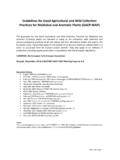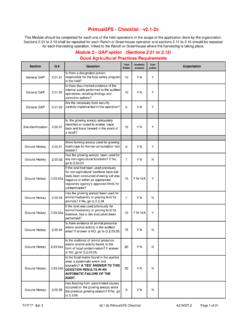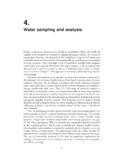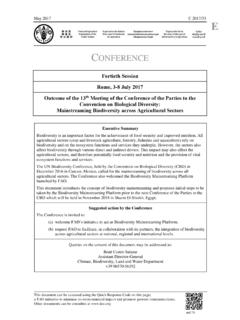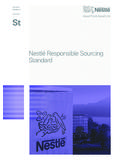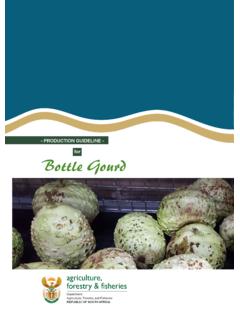Transcription of Animal diseases prevention and control - Home: OIE
1 The Animal disease prevention and control activities of Veterinary Services throughout the world are a Global Public good . These activities have major benefits for agricultural production, food security and safety, public health, Animal welfare, access to markets and alleviation of rural poverty. The effectiveness of prevention and control policies depends on the good governance and quality of the Veterinary Services, in compliance with OIE standards and guidelines on Animal disease diseases prevention and controlFact sheetsCONTROLLING diseases AT THEIR Animal SOURCEN ational Veterinary Services are at the very core of the system for the prevention and control of Animal diseases . Among other aspects, they are responsible for early detection and rapid response to outbreaks of emerging or re-emerging Animal diseases .
2 Enhancing the governance of Veterinary Services must be the focus worldwide, aimed at optimising the quality and effectiveness of disease prevention and control systems, based on suitably adapted Veterinary Services in developing and in-transition countries require suitably adapted legislation and the human and financial resources to enforce it, as well as capacity-building, in order to protect Animal health and thus public health, including food security and food SURVEILLANCE Upstream of Animal disease prevention and control activities, there must be effective active (planned) or passive (event-based) surveillance. The OIE defines surveillance as The systematic ongoing collection, collation, and analysis of data, and the timely dissemination of information to those who need to know so that action can be taken.
3 (OIE Terrestrial Animal Health Code).To be effective, this strategy requires optimal communication and collaboration between all stakeholders at all levels of the Animal production chain, from the Animal producer, her/his veterinarian and the local laboratory, to the highest national veterinary DETECTION OF DISEASESAn early detection system enables the timely detection and identification of an incursion or emergence/re-emergence of a disease/infection in a given country, zone or compartment. It must be under the official control of the Veterinary Services complying with relevant OIE standards and includes the following characteristics: representative coverage of target Animal populations, by field services throughout the territory in good cooperation with farmers and stakeholders; ability to undertake effective epidemiological investigations and reporting; access to laboratories capable of diagnosing and differentiating relevant diseases ; a training programme for veterinarians, veterinary para-professionals and other stakeholders for detecting and reporting Animal health incidents; the legal obligation for private veterinarians to report to the national Veterinary Authority.
4 A well-established national chain of SamplesIn order to have a rapid and effective diagnosis of any new disease occurrence, the veterinary authorities must have a response mechanism for sample collection and laboratory analysis. Particularly in developing countries, the shortage of field veterinarians often means that disease detection and sample collection operations have to be entrusted to suitably trained farmers or para professionals under close supervision of accredited aware of a disease outbreak, the veterinary authorities must ensure that the national and international community is well alerted, and that a final confirmation and characterisation of the pathogen be determined, if necessary in an OIE Reference Laboratory for the specified disease. OIE has a global network of 296 Reference Laboratories and Collaborating Centres covering all relevant Animal diseases .
5 (See Cartography).NOTIFICATION OF Animal diseases TO THE OIEThe OIE ensures the transparency of the world Animal health situation. On becoming an OIE Member, each country undertakes to report the terrestrial and aquatic Animal health situation in its territory in a timely and transparent 180 OIE Member Countries can connect to the OIE server at any time to fulfil their obligation to provide information, in a timely manner, on any relevant domestic or wild Animal disease detected within their FACTS Effective surveillance, early detection, transparency and rapid response mechanisms are key to prevent and control Animal diseases . good governance of Veterinary Services is crucial to improve Animal health worldwide. The OIE publishes standards and guidelines for the prevention and control of terrestrial and aquatic Animal diseases in its Codes and Manuals as well as in its various scientific and aquatic diseases listed by the OIE The OIE List currently includes 119 terrestrial and aquatic Animal diseases identified as being of great importance for Animal and public health, on the basis of characteristics defined in the OIE Terrestrial and Aquatic Codes.
6 This list is reviewed on a regular basis and all proposed modifications must be adopted by the World Assembly of Delegates at its annual General also: OIE Fact sheet Aquatic Animals Animal diseases prevention and 2015 Contact: is very useful in the prevention and control of many diseases , if it conforms to an existing disease control programme. However, vaccination on its own will not usually achieve the desired results unless the vaccination programme is part of an integrated control strategy utilising a combination of control a vaccination strategyIf it is determined that vaccination is an option, before launching a specific vaccination policy Member Countries need to make sure that the preconditions for a successful outcome have been met, ensuring vaccine quality and defining the conditions under which any vaccination policy must eventually be stopped (exit strategy).
7 Vaccine qualityVaccines should be produced in accordance with international guidelines prescribed in the OIE Manual of Diagnostic Tests and Vaccines for Terrestrial Animals. For most vaccines, ensuring a permanent cold chain (constant temperature control ) is critical to the successful implementation of a vaccination campaign. In some developing regions the OIE has created regional vaccine banks for rabies, foot and mouth disease and peste des petits ruminants to provide support for its Member Countries in case of an emergency situation. Animal identification and traceabilityAnimal identification and traceability are very useful tools in the effective control of Animal diseases . In case of outbreaks, such measures will make it easier to identify animals and Animal products potentially exposed to the pathogen and allow them to be traced, so that the appropriate control measures can be implemented.
8 The application of Animal identification and traceability should comply with OIE version: more information OIE Terrestrial Animal Health Code Volume I: horizontal standards Notification of Animal diseases Animal health surveillance Volume II: vertical standards (management of OIE-Listed diseases ) OIE Manual of Diagnostic Tests and Vaccines for Terrestrial Animals Animal disease summaries Guidelines for Animal disease control Guide to Terrestrial Animal Health SurveillanceThis information must be notified to the OIE by the Veterinary Services of Member Countries through the World Animal Health Information system (WAHIS), within 24 h after confirmation for exceptional epidemiological events and on a six-monthly basis for monitoring purposes.
9 Non-member countries can also communicate their sanitary information through WAHIS and they can also publish details of their national disease simulation is a key measure to ensure transparencyThe existence of a rapid and fair compensation scheme, after culling of infected animals imposed by the Veterinary Services, encourages early notification of diseases by Animal producers, who are the first to detect the occurrence of diseases . Producers will more readily report a disease occurrence to Veterinary Services if they are sure of receiving compensation for losses suffered as a result of stamping-out RESPONSE MECHANISMSB iosecurityBiosecurity policies and measures taken to protect human and Animal health from biological risks are essential.
10 In the case of a disease outbreak in a non-endemic area, depopulation (by humane killing of infected and in-contact animals, in accordance with OIE standards), followed by disinfection of establishments, equipment and vehicles, in conjunction with a temporary ban or control of movements animals, will often be sufficient to prevent the spread of the pathogen. Appropriate biosecurity measures must be implemented throughout the world. Member Countries must comply with OIE standards and guidelines, by ensuring that all those involved are properly trained and by providing them with the necessary material and human and compartmentalisationMaintaining trade despite the presence of diseases in the national territoryTo make it possible for countries with areas that are partially infected with diseases to access international markets without placing importers at risk, the OIE has defined several concepts in the Terrestrial Code: Zoning allows a country to isolate parts of its territory that are free from certain diseases from other areas that are still infected.










